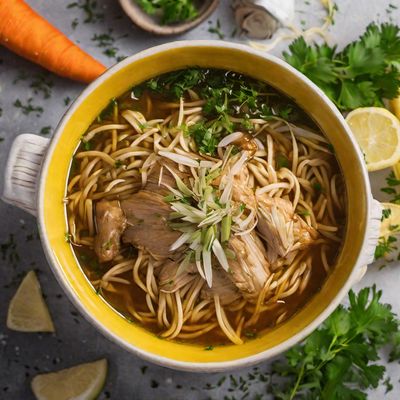
Ingredient
Brazilian guavas
The Tropical Delight of Brazil
Brazilian guavas have a green or yellow skin with a soft, juicy flesh that ranges from white to pink. They have a unique flavor profile that combines sweetness with a hint of tartness, reminiscent of a blend of strawberries and pears. The texture is creamy and granular, similar to a ripe pear. These fruits are often enjoyed fresh or used in various culinary applications.
Origins and history
Guavas are native to Central and South America, with Brazil being one of the primary producers of this fruit. They have a long history in Brazilian culture and are considered a symbol of fertility and abundance. Guavas were introduced to other parts of the world by Portuguese explorers and have since become popular in tropical and subtropical regions.
Nutritional information
Brazilian guavas are a rich source of vitamin C, dietary fiber, and antioxidants. They also contain small amounts of essential minerals like potassium and magnesium. Additionally, they are low in calories and fat, making them a healthy choice for snacking or incorporating into various dishes.
How to select
When selecting Brazilian guavas, choose fruits that are firm, plump, and free from blemishes or bruises. The skin should have a slight give when gently pressed. Avoid fruits that are overly soft or have a strong odor, as they may be overripe or spoiled.
Storage recommendations
To prolong the shelf life of Brazilian guavas, store them in the refrigerator. However, they are best enjoyed when ripe and at room temperature. If the fruits are not fully ripe, they can be placed in a paper bag to speed up the ripening process. Once ripe, consume them within a few days for the best flavor and texture.
How to produce
Brazilian guavas can be grown in tropical and subtropical regions with warm temperatures and well-drained soil. They require full sun exposure and regular watering. While they can be challenging to grow in colder climates, they can be cultivated in containers and brought indoors during winter months.
Preparation tips
Brazilian guavas can be enjoyed fresh by simply cutting them in half and scooping out the flesh with a spoon. They can also be used in smoothies, juices, jams, jellies, or desserts like pies and tarts. The seeds are edible but can be strained out if desired. The fragrant leaves of the guava tree can be used to infuse teas or used as a flavoring in cooking.
Culinary uses
Brazilian guavas are commonly used in Brazilian cuisine to make juices, desserts, and sweets. They are also enjoyed as a refreshing snack on their own. In addition to culinary uses, guavas are used in traditional medicine and herbal remedies due to their potential health benefits.
Availability
Brazilian guavas are primarily cultivated and consumed in Brazil, as well as other tropical regions in South America, Central America, and the Caribbean. They can also be found in some specialty stores or imported to other countries.
More ingredients from this category
Recipes using Brazilian guavas

Huevos Rancheros with a Brazilian Twist
Brazilian-Style Huevos Rancheros: A Flavorful Fusion of Mexican and Brazilian Cuisine

Sopa de Frango e Macarrão
Brazilian Chicken Noodle Soup

Brazilian-style Red Pozole
Feijoada-inspired Red Pozole: A Brazilian Twist on a Mexican Classic

Kung Pao Chicken - Brazilian Style
Brazilian Spiced Kung Pao Chicken

